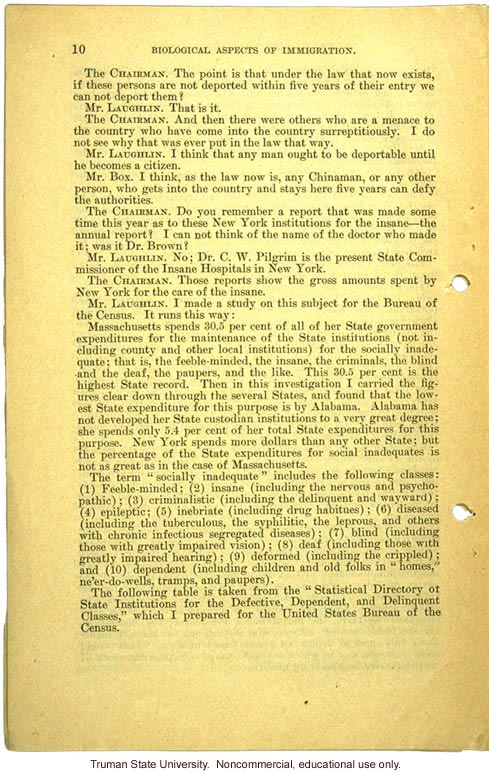10 Biological Aspects of Immigration.
The Chairman. The point is that under the law that now exists, if these persons are not deported within five years of their entry we can not deport them?
Mr. Laughlin. That is it.
The Chairman. And then there were others who are a menace to the country who have come into the country surreptitiously. I do not see why that was ever put into the law that way.
Mr. Laughlin. I think that any man ought to be deportable until he becomes a citizen.
Mr. Box. I think, as the law now is, any Chinaman, or any other person, who gets into the country and stays here five years can defy the authorities.
The Chairman. Do you remember a report that was made some time this year as to these New York institutions for the insane - the annual report? I can not think of the name of the doctor who made it; was it Dr. Brown?
Mr. Laughlin. No; Dr. C. W. Pilgrim is the present State Commissioner of the Insane Hospitals in New York.
The Chairman. Those reports show the gross amounts spent by New York for the care of the insane.
Mr. Laughlin. I made a study on this subject for the Bureau of the Census. It runs this way:
Massachusetts spends 30.5 per cent of all of her State government expenditures for the maintenance of the State institutions (not including county and other local institutions) for the socially inadequate; that is, the feeble-minded, the insane, the criminals, the blind and the deaf, the paupers, and the like. This 30.5 per cent is the highest State record. Then in this investigation I carried the figures clear down through the several States, and found that the lowest State expenditure for this purpose is by Alabama. Alabama has not developed her State custodian institutions to a very great degree; she spends only 5.4 per cent of her total State expenditures for this purpose. New York spends more dollars that any other State; but the percentage of the State expenditures for social inadequates is not as great as in the case of Massachusetts.
The term "socially inadequate" includes the following classes: (1) Feeble-minded; (2) insane (including the nervous and psychopathic); (3) criminalistic (including the delinquent and wayward); (4) epileptic; (5) inebriate (including drug habitué); (6) diseased (including the tuberculous, the syphilitic, the leprous, and others with chronic infection segregated diseases); (7) blind (including those with greatly impaired vision); (8) deaf (including those with greatly impaired hearing); (9) deformed (including the crippled); and (10) dependent (including children and old folks in "homes," ne'er-do-wells, tramps, and paupers).
The following table is taken from the "Statistical Directory of State Institutions for the Defective, Dependent, and Delinquent Classes," which I prepared for the United States Bureau of the Census.


